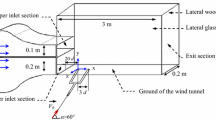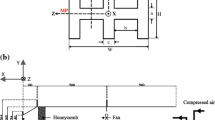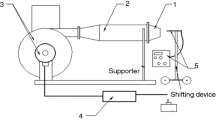Abstract
Mixing characteristics in a rectangular chamber are investigated using experimental and numerical methods. A mixing chamber with an axial inlet (representing fuel inlet) and a side inlet (representing air inlet) is designed. Two jets with different momentum ratios through the two inlets are mixed in the chamber. Computational fluid dynamic simulation is validated by experimental data of particle image velocimetry that measures flow velocity distribution. The momentum ratios of the two jets and the height of the axial inlet significantly influence the penetration depth of axial jet into the mixing chamber and the pressure drops at recirculation zones.
Similar content being viewed by others
References
M. Nagai, Y. Muroi, Y. Suti, W. Saito, M, Tanabe and T kuwahara, Ignition and combustion characteristic in the recirculation zone of ducted rockets -effects of titanium, Magnesium and Boron Particles Addition-, 45 th AIAA/ASME/SAE/ASEE Joint Propulsion Conference & Exibit, Denver, Colorado (2009) AIAA 2009-5388.
T. Feraille, G. Casalis and J. Dupays, Particle effects on solid-propellant motors flow stability, 38 th AIAA/ASME/SAE/ASEE Joint Propulsion Conference & Exibit, Indianapolis, Indiana (2002) AIAA 2002-3611.
T kuwahara, K. Obuchi and M. Tanabe, Mass transfer in the recirculation zone of ducted rocket, 44 th AIAA/ASME/SAE/ASEE Joint Propulsion Conference & Exibit, Hartford, CT (2008) AIAA 2008-4892.
W. H. Hsieh, C. L. Chuang, A. S. Yang, D. L. Cherng, V. Yang and K. K. Kuo, Measurement of flowfield in a simulated solid-propellant ducted rocket combustor using laser doppler velocimetry, AIAA/ASME/SAE/ASEE 25 th Joint Propulsion Conference, Monterey, CA (1989) AIAA-89-2789.
R. A. Stowe, A. DeChamplain, A. E. H. J. Mayer and S. F. Niemeijer, Modelling and Flow Visualization in a Ducted Rocket Combustor, AIAA-98-3768.
R. A. Stowe, C. Dubois, P. G. Harris, A. E. H. J. Mayer, A. de Champlain and S. Ringuette, Performance prediction of a ducted prediction of a ducted rocket combustor using a simulated solid fuel, Journal of Propulsion and Power, 20(5) (2004) 936–944.
A. Ristori and E. Dufour, Numerical simulation of ducted rocket motor, 37th AIAA/ASME/SAE/ASEE Joint Propulsion Conference & Exhibit, Salt Lake City, Utah (2011).
H. Nakayama, Y. Ikegami, A. Yoshida, K. Koori, K. Watanabe, H. Tokunaga, H. Shimizu and S. Kanaizumi, Fullscale firing tests of variable flow ducted rocket engines employing GAP solid fuel gas generator, 45th AIAA/ASME/SAE/ASEE Joint Propulsion Conference & Exhibit, Denver, Colorado (2009).
Z. Xia, J. Hu, D. Fang, J. Guo and W. Zhang, Combustion study of the boron particle in the secondary chamber of ducted rocket, 42nd AIAA/ASME/SAE/ASEE Joint Propulsion Conference & Exhibit, Sacramento, Califonia, AIAA 2006-4445.
ANSYS FLUENT 12.0 Theory Guide, April (2009).
B. Van Leer, Toward the ultimate conservative difference scheme. IV. A Second Order Sequel to Godunov’s Method, Journal of Computational Physics, 32 (1979) 101–136.
K. Kadoya, N. Matsunaga and A. Nagashima, Viscosity and thermal conductivity of dry air in the gaseous phase, J. Phys. Chem. Ref. Data, 14(4) (1985).
Author information
Authors and Affiliations
Corresponding author
Additional information
Recommended by Associate Editor Yang Na
Doo-Hee Han received his B.S. degree from the Department of Aerospace and Mechanical Engineering at the Korea Aerospace University in 2013. He is currently a master candidate in the School of Aerospace and Mechanical Engineering at the Korea Aerospace University in Goyang City, Korea. His research interests are metal particle combustion and numerical simulation.
Jun-Su Shin received his B.S. and M.S. degrees from the Department of Aerospace and Mechanical Engineering at the Korea Aerospace University in 2010 and 2012, respectively. He is currently a Ph.D. candidate in the School of Aerospace and Mechanical Engineering at the Korea Aerospace University in Goyang City, Korea. His research interests include Ram, Scramjet propulsion, DDES simulation, and HEM.
Jeong-Seok Kang received his B.S. degree from in the School of Aerospace and Mechanical Engineering at the Korea Aerospace University in Goyang City, Korea. His research interests are metal particle combustion and numerical simulation.
Jung-Shin Park received his B.S. and M.S. degrees from the Department of Aerospace and Mechanical Engineering at the Korea Aerospace University in 2010 and 2012, respectively. He is currently a Ph.D. candidate in the School of Aerospace and Mechanical Engineering at the Korea Aerospace University in Goyang City, Korea. His research interests are aerodynamics and heat transfer in a gas turbine blade.
Soon-Sang Park received his B.S. degree from the Department of Aerospace and Mechanical Engineering at the Korea Aerospace University in 2013. He is currently a master’s candidate in the School of Aerospace and Mechanical Engineering at the Korea Aerospace University in Goyang City, Korea. His research interests are film cooling and heat transfer in a gas turbine blade.
Jae-Su Kwak received his B.S. and M.S. degrees in Mechanical Engineering from Korea University in 1996 and 1998, respectively. He then received his Ph.D. from Texas A&M University in 2002. Dr. Kwak is currently an Associate Professor in the School of Aerospace and Mechanical Engineering at the Korea Aerospace University in Goyang City, Korea. His main research interests include gas turbine heat transfer, heat transfer in a propulsion system, and enhancement of heat transfer.
Hong-Gye Sung received his B.S. degree from the Department of Aerospace Engineering at Inha University in 1984 and his Ph.D. degree in Nuclear and Mechanical Engineering from The Pennsylvania State University in 1999. Dr. Sung worked at the Agency for Defense Development for 22 years (1984–2006) and obtained various research experiences in the fields of high-speed propulsion and rocket propulsion. He is currently a professor in the School of Aerospace and Mechanical Engineering at the Korea Aerospace University in Goyang City, Korea. Dr. Sung’s research interests are propulsion, combustion, and its control.
Ho-Jin Choi received his B.S. and Ph.D. degrees in Mechanical Engineering from the Seoul National University in 1998 and 2010, respectively. Dr. Choi is a senior researcher at the Advanced Propulsion Center of the Agency for Defense Development in Daejeon, Korea. He has been working in the field of air-breathing engine, such as Turbo jet, Ramjet, and Scramjet, since 2002. His research interests include combustion and laser diagnostics.
Rights and permissions
About this article
Cite this article
Han, DH., Shin, JS., Kang, JS. et al. Numerical and experimental studies on the mixing characteristics of two jets with inclined angles in a rectangular chamber. J MECH SCI TECHNOL 28, 4083–4090 (2014). https://doi.org/10.1007/s12206-014-0921-9
Received:
Revised:
Accepted:
Published:
Issue Date:
DOI: https://doi.org/10.1007/s12206-014-0921-9




